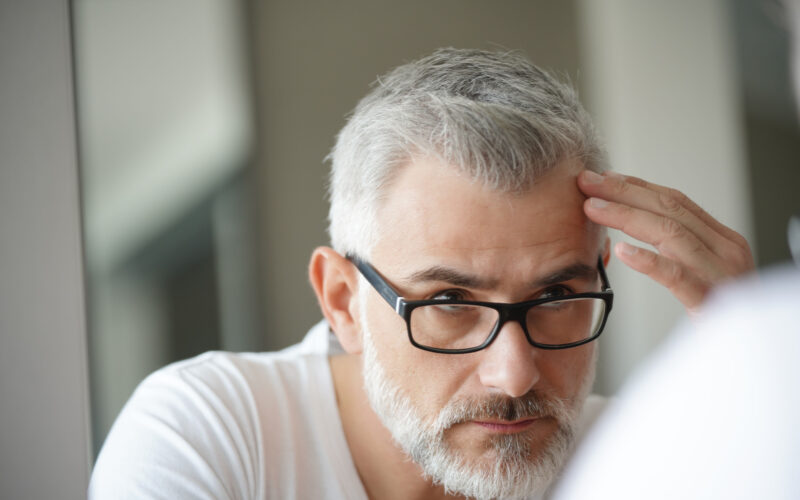Most guys dealing with thinning hair follow the same playbook: grab some minoxidil, maybe consider finasteride, and hope for the best. But here’s the thing—those conventional approaches only address part of the problem. Hair loss is rarely just about one factor, and treating it that way explains why so many men end up frustrated with their results.
The reality is that male pattern baldness operates through multiple pathways. Genetics load the gun, but factors such as inflammation, nutritional deficiencies, stress hormones, and poor circulation all pull the trigger. Focusing exclusively on DHT (the hormone most associated with hair loss) while ignoring everything else is the equivalent of trying to fix a car by only checking the oil.
The Multi-Factor Problem Nobody Talks About
When hair follicles start miniaturizing, several things happen at once. Blood flow to the scalp decreases, which means fewer nutrients reach the follicles. Inflammation sets in around the hair roots, creating an environment where healthy growth becomes difficult. Stress elevates cortisol levels, which directly disrupts the hair growth cycle. Add in potential deficiencies in nutrients that hair follicles depend on—things such as biotin, zinc, and specific amino acids—and you’ve got a perfect storm.
The problem is that most treatments only tackle one piece of this puzzle. Minoxidil improves blood flow but doesn’t address inflammation or nutritional gaps. Finasteride blocks DHT but does nothing for stress-related cortisol or deficient nutrient levels. This is where it gets expensive, by the way—men often end up stacking multiple single-target treatments when what they really need is a more comprehensive approach.
Why Supplements Deserve Another Look
There’s been a shift in how dermatologists and hair specialists think about supplementation for hair loss. Not the bargain-bin biotin pills that promise miracles, but medical-grade formulations designed to address multiple contributing factors at once. These aren’t magic bullets, but they do something that topical treatments can’t: they work from the inside to create better conditions for hair growth.
Quality matters enormously here. Professional-grade supplements go through different manufacturing standards than what you’ll find at the drugstore, and the ingredient sourcing makes a real difference in how the body actually absorbs and uses what you’re taking. For men looking for this caliber of product, options such as nutrafol for men represent the science-backed end of the supplement market, formulated specifically to target multiple hair loss pathways rather than just throwing random vitamins at the problem.
The distinction between medical-grade and standard supplements comes down to a few key factors. Better formulations use standardized botanical extracts with consistent potency, include ingredients in their most bioavailable forms, and combine components that work synergistically rather than just listing popular ingredients. Most drugstore hair supplements are essentially expensive multivitamins with some biotin thrown in.
The Stress Connection That Most Guys Miss
Cortisol doesn’t just make you feel terrible—it actively shortens the growth phase of hair follicles. When stress becomes chronic, hair spends less time growing and more time in the resting phase before it sheds. This creates a thinning effect that has nothing to do with DHT or genetics.
What makes this particularly tricky is that stress-related hair loss often shows up months after the actual stressful period. A rough patch at work in January might not show visible thinning until April or May, which makes it harder to connect the dots. Most men don’t realize their receding hairline has anything to do with their sleep quality or work stress.
Managing cortisol levels isn’t about bubble baths and meditation apps (though those don’t hurt). It’s about consistent sleep schedules, regular exercise that doesn’t overtrain the body, and yes, ensuring the body has the nutritional resources to handle stress properly. Adaptogens—plant compounds that help regulate the stress response—have become a focus in better hair loss supplements for exactly this reason.
Inflammation: The Invisible Accelerator
Chronic low-grade inflammation around hair follicles speeds up the miniaturization process. This inflammation can come from various sources: poor diet, environmental toxins, autoimmune responses, or even the scalp’s reaction to its own oil production. Anti-inflammatory approaches work, but they need to be sustained over time to make a difference.
This is where a lot of topical treatments fall short. They sit on the scalp surface but don’t address systemic inflammation that’s affecting follicle health from the inside. Combining external and internal approaches tends to produce better outcomes than either alone, which makes sense when you think about how interconnected these systems are.
Omega-3 fatty acids, curcumin, and certain botanical extracts have solid research backing their anti-inflammatory effects. The catch is that you need therapeutic doses, not the trace amounts in most standard supplements. Professional formulations account for this by including concentrated extracts standardized to specific active compounds.
Setting Realistic Expectations
Here’s what nobody wants to hear: hair regrowth takes time, and not every follicle can be saved. If a follicle has been dormant for years, the odds of reviving it drop significantly. But follicles in earlier stages of miniaturization—those producing thinner, shorter hairs—can often be brought back to fuller function with the right approach.
The timeline matters. Most men give up on treatments after two or three months when they don’t see dramatic results. But the hair growth cycle itself takes three to six months to complete. Real assessment of whether something is working can’t happen until the six-month mark at minimum, and more often, noticeable improvement takes eight to twelve months.
This is where consistency becomes critical. Missing doses, taking breaks, or switching products every few months means never giving any approach enough time to work. The men who see the best results are usually the ones who commit to a protocol for at least a year before making judgments.
The Bottom Line
Effective hair loss treatment for most men requires addressing multiple factors rather than pinning everything on a single solution. DHT matters, but so does circulation, inflammation, stress hormones, and nutritional status. The most successful approaches tend to combine strategies that work through different mechanisms—whether that means pairing a topical with a comprehensive supplement, managing stress levels while improving diet, or working with a dermatologist on a multi-pronged protocol.
The key is understanding that hair loss is rarely simple, and neither are the solutions. Quick fixes and single-ingredient products work for some guys, but most men dealing with progressive thinning need a more thorough strategy. Starting earlier rather than later makes everything easier, since there are more follicles to work with before permanent loss sets in.










One thing I have seen work alongside such strategies is finding a trusted barber who understands hair loss nuances. For example, at Great Style Barbershop NYC on the Upper East Side, the barbers not only style your hair but also take into account its health – which makes a surprising difference when you are dealing with thinning or receding areas. Their tailored cuts, combined with a regimen that tackles internal and external factors, can really help you feel more confident in the process https://greatstylebarbershopnyc.com/